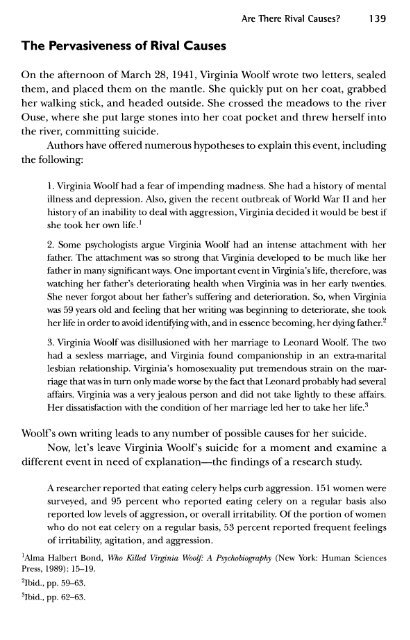Asking the Right Questions, A Guide to Critical Thinking, 8th Ed
Asking the Right Questions, A Guide to Critical Thinking, 8th Ed
Asking the Right Questions, A Guide to Critical Thinking, 8th Ed
Create successful ePaper yourself
Turn your PDF publications into a flip-book with our unique Google optimized e-Paper software.
Are There Rival Causes? 139<br />
The Pervasiveness of Rival Causes<br />
On <strong>the</strong> afternoon of March 28, 1941, Virginia Woolf wrote two letters, sealed<br />
<strong>the</strong>m, and placed <strong>the</strong>m on <strong>the</strong> mantle. She quickly put on her coat, grabbed<br />
her walking stick, and headed outside. She crossed <strong>the</strong> meadows <strong>to</strong> <strong>the</strong> river<br />
Ouse, where she put large s<strong>to</strong>nes in<strong>to</strong> her coat pocket and threw herself in<strong>to</strong><br />
<strong>the</strong> river, committing suicide.<br />
Authors have offered numerous hypo<strong>the</strong>ses <strong>to</strong> explain this event, including<br />
<strong>the</strong> following:<br />
1. Virginia Woolf had a fear of impending madness. She had a his<strong>to</strong>ry of mental<br />
illness and depression. Also, given <strong>the</strong> recent outbreak of World War II and her<br />
his<strong>to</strong>ry of an inability <strong>to</strong> deal with aggression, Virginia decided it would be best if<br />
she <strong>to</strong>ok her own life. 1<br />
2. Some psychologists argue Virginia Woolf had an intense attachment with her<br />
fa<strong>the</strong>r. The attachment was so strong that Virginia developed <strong>to</strong> be much like her<br />
fa<strong>the</strong>r in many significant ways. One important event in Virginia's life, <strong>the</strong>refore, was<br />
watching her fa<strong>the</strong>r's deteriorating health when Virginia was in her early twenties.<br />
She never forgot about her fa<strong>the</strong>r's suffering and deterioration. So, when Virginia<br />
was 59 years old and feeling that her writing was beginning <strong>to</strong> deteriorate, she <strong>to</strong>ok<br />
her life in order <strong>to</strong> avoid identifying with, and in essence becoming, her dying fa<strong>the</strong>r. 2<br />
3. Virginia Woolf was disillusioned with her marriage <strong>to</strong> Leonard Woolf. The two<br />
had a sexless marriage, and Virginia found companionship in an extra-marital<br />
lesbian relationship. Virginia's homosexuality put tremendous strain on <strong>the</strong> marriage<br />
that was in turn only made worse by <strong>the</strong> fact that Leonard probably had several<br />
affairs. Virginia was a very jealous person and did not take lightly <strong>to</strong> <strong>the</strong>se affairs.<br />
Her dissatisfaction with <strong>the</strong> condition of her marriage led her <strong>to</strong> take her life. 3<br />
Woolf s own writing leads <strong>to</strong> any number of possible causes for her suicide.<br />
Now, let's leave Virginia Woolf's suicide for a moment and examine a<br />
different event in need of explanation—<strong>the</strong> findings of a research study.<br />
A researcher reported that eating celery helps curb aggression. 151 women were<br />
surveyed, and 95 percent who reported eating celery on a regular basis also<br />
reported low levels of aggression, or overall irritability. Of <strong>the</strong> portion of women<br />
who do not eat celery on a regular basis, 53 percent reported frequent feelings<br />
of irritability, agitation, and aggression.<br />
'Alma Halbert Bond, Who Killed Virginia Woolf: A Psychobiography (New York: Human Sciences<br />
Press, 1989): 15-19.<br />
2 Ibid., pp. 59-63.<br />
3 Ibid., pp. 62-63.



